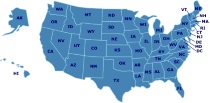Geology
Rocks and minerals can be found in your own backyard. Explore the world around you and learn about the history of the formation of the Earth by studying geology. We've gathered resources to make it fun and interesting.
Things to See & Do in Kentucky
Mammoth Cave National Park
Mammoth Cave National Park was established to preserve the cave system, including Mammoth Cave, the scenic river valleys of the Green and Nolin rivers, and a section of south central Kentucky. This is the longest recorded cave system in the world with more than 360 miles explored and mapped. The Park is located between Louisville and Nashville.
Appalachian National Scenic Trail
The Appalachian National Scenic Trail is a 2,180-mile footpath along the ridgecrests and across the major valleys of the Appalachian Mountains from Katahdin in Maine to Springer Mountain in northern Georgia. It traverses the scenic, wooded, pastoral, wild, and culturally resonant lands of the Appalachian Mountains. Conceived in 1921, it was built by private citizens and completed in 1937. The trail traverses Maine, New Hampshire, Vermont, Massachusetts, Connecticut, New York, New Jersey, Pennsylvania, Maryland, West Virginia, Virginia, Tennessee, North Carolina and Georgia.
Big South Fork National River & Recreation Area
The free-flowing Big South Fork of the Cumberland River and its tributaries pass through 90 miles of scenic gorges and valleys containing a wide range of natural and historic features. The area offers a broad range of recreational opportunities including camping, whitewater rafting, kayaking, canoeing, hiking, horseback riding, mountain biking, hunting and fishing. The U.S. Army Corps of Engineers, with its experience in managing river basins, was charged with land acquisition, planning and development of facilities. Now completed, these lands and facilities are operated and maintained by the National Park Service for the benefit and use of the public.
Louisville Science Center
The Louisville Science Center is the State Science Center of Kentucky. The Center encourages the understanding of science, mathematics and technology through hands-on exhibits, IMAX® films and educational programs.
Featured Resources
As an Amazon Associate, we earn from qualifying purchases. We get commissions for purchases made through links on this site.
Minds More Awake: The Vison of Charlotte Mason
Anne E. White explores what is known as the Charlotte Mason, based on the educational philosophy of the 19th century British educator. The goal is to set a child on the path to an intentional, purposeful life. White explores both the practical and philosophical understanding the Mason's practices. White includes lots of examples of how to use these ideas in your own homeschooling.
The Organizing Sourcebook : Nine Strategies for Simplifying Your Life
The nine habits of highly organized people Organizing consultant Kathy Waddill demonstrates how the simple act of being organized can improve your quality of life. In The Organizing Sourcebook, she presents nine organizing principles that can easily be applied to any situation, activity, or environment. The book gives you the tools for managing time; decreasing stress; and dealing with cultural, personal, and emotional change. Case histories illustrate how each strategy solved a specific proble...
The Ultimate Book of Homeschooling Ideas: 500+ Fun and Creative Learning Activities for Kids Ages 3-12
Fun and Effective Home Learning Activities for Every SubjectAs a homeschooling parent, you're always looking for new and creative ways to teach your child the basics. Look no longer! Inside this innovative helper, you'll find kid-tested and parent-approved techniques for learning math, science, writing, history, manners, and more that you can easily adapt to your family's homeschooling needs. And even if you don't homeschool, you'll find this book a great teaching tool outside the classroom. You...
Montessori Play And Learn : A Parent's Guide to Purposeful Play from Two to Six
We all want the best possible starts in life for our children, and one of the best possible starts in life, educationally, is the "method" pioneered by Maria Montessori and taught successfully today throughout the world.Now, Lesley Britton, the leading Montessori practitioner in England for more than twenty years, will show parents how to bring Montessori home. If you would like to facilitate the development of your child's unique personality, make it possible for him to develop to his full inte...
Homeschool Bravely: How to Squash Doubt, Trust God, and Teach Your Child with Confidence
It's time to change your perspective to transform the way you plan, teach, and homeschool. This book helps you to see homeschooling as a calling. With this mindset, you'll be able to dismiss the stress of impossible expectations. Find strategies to help you juggle the logistics of homeschooling with different ages, be a good support for a struggling learner, set realistic goals, dismiss the guilt, and weather any criticism. You can be a hopeful homeschooler! God uses all for good and can transfo...





